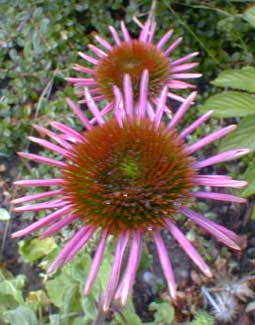
'Ruby Star' Echinacea; aka,
'Rubinstern' Purple Coneflower
"Brave flowers — that I could be gallant as you,
and be as little vain!"
-Henry King, Bishop of Chichester
(1592-1669)
(1592-1669)
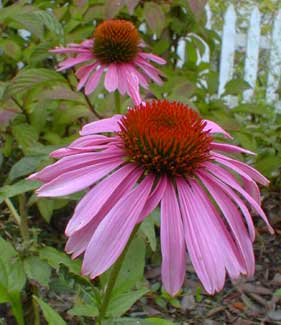 I. 'Ruby Star' for the Garden
I. 'Ruby Star' for the Garden
We have several cultivars of Echinacea purpurea, most selected because they are semi-dwarfs thus fit the perspective of our smallish streetside sun-garden, better than would towerlingly full-sized echinaceas such as 'Magnus.'Three clumps of 'Ruby Star' are pictured in various months & years on this page. The fourth photo below of 'Ruby Star' was snapped its first year in the garden, late one August (2002). It started out as a low-growing rosette of large purple-blushed foliage only about a foot tall; the leaves were quite a bit bigger than on 'Kim's Knee High.' By the time they're ready to bloom 'Ruby Star' had begun to heighten to two or three feet & the blooming stems continue upward to three feet.
The first photo above shows young flowers in July (2004), with the petals not yet fully matured. The second photo is from August's end.
The fifth photo below is from July (2005), in contrast to the sixth photo showing the flowers in October (2004), still vibrant but with petals a mite deformed, apparently due to a couple mild frosts as these last complete blooms for the were developing. The clump would attempt to produce a couple more flowers in winter but the cold stunted them.
The flowers are quite similar to 'Kim's Knee High,' but the cone of 'Ruby Star' ages to the deepest blood-red sometimes verging on black, while on 'Kim's' the cones tend to remain yellow-orange. A single clump of 'Kim's' has also spread into a broad clump much more rapidly than has 'Ruby Star,' & all tje 'Ruby Star' clumps begin to bloom three or four weeks later than 'Kim's Knee-high.'
There was a fourth clump of 'Ruby Star' that did not survive its first winter perhaps because it was still so active & blooming even after frosts began. The remaining three clumps have always seemed to be a bit weaker in spirit than 'Kim's Knee High,' but this may be an illusion caused by the one clump of 'Kim's' being on a higher hump of soil & draining better. The others could well be a little moister than they'd prefer when autumn rains arrive, & that's enough to keep them stuntier & slower to become big clumps.
About the only thing that can kill a 'Ruby Star' is overwatering or poor-draining soil. It's otherwise hardy as the devil. It's cold-hardy at minus thirty to twenty degrees, & does not suffer from heat. Like all E. purpurea cultivars, it wants full sun but tolerates partial shade. It likes rich loamy soil but really doesn't require fertilizing.
The cold-hardiness lends Echinacea a degree of winter interest. They're certainly not at their height of beauty in winter, & some gardeners will prefer to cut them back when they begin to get scruffy late in autumn or early winter.
I've trimmed them back some years when they were particularly unsightly, but I wait as long as possible, & prefer to trim out only what wears out the worst, keeping as much of the clump as possible (sometimes as late as February), at which time anything remaining of the previous year's growth I cut back to make room for new growth.
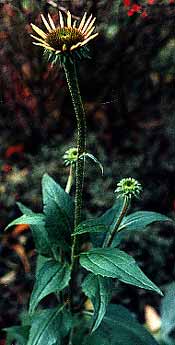 In the mildest of our mild winters, it will flower to year's end, though the flowers will not be the same big bright things seen in summer. The third photo shows 'Ruby Star' in November, still in bloom, but the weather is too cold for the flowers to quite complete themselves; this is as far as winter rebloom will get.
In the mildest of our mild winters, it will flower to year's end, though the flowers will not be the same big bright things seen in summer. The third photo shows 'Ruby Star' in November, still in bloom, but the weather is too cold for the flowers to quite complete themselves; this is as far as winter rebloom will get.The resulting half-formed starbursts are like an entirely different kind of blossom on the same perennial that was so much showier in summer, & I like to encourage these winter partial-reblooms. December & January rebloom is even more stunted, pint-size pink stars above withering & darkening leaves.
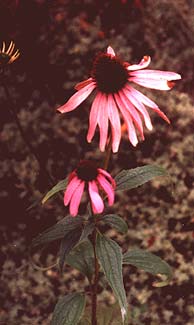 Most gardeners will prefer to just cut them back late in autumn & not let them waste energy struggling for an unnecessary winter presence. Permitting this winter activity, & failing to cut them back in a more timely way, tires the clump so that it spreads more slowly than it would otherwise.
Most gardeners will prefer to just cut them back late in autumn & not let them waste energy struggling for an unnecessary winter presence. Permitting this winter activity, & failing to cut them back in a more timely way, tires the clump so that it spreads more slowly than it would otherwise.But I can't see that the main summer through early autumn blooms are any less impactful, & even if the clump enlarges more slowly, that mainly means it will be an extra year or two before the clump is so big it needs to be dug up & divided. It is possible, I suppose, that the reason we lost one clump was from encouraging their ability to tepidly rebloom in winter.
Winter attempts at reblooms get stuntier & stuntier, & more parts of the clump need to be clipped out as they blacken, until by late February there's usually nothing left to clip back. In mid to late February it begins producing new basal leaves. If any of the stunty winter flowers do remain as spring nears, the stems & leaves will be too deteriorated to justify saving them any longer. So it's time to remove all the previous year's remnant if any remains so late as March 1st.
Some may think it's a bit nutty that I enjoy the half-decaying, scruffy-leafed, half-blooming mid- to late-winter clumps, & I'm certainly not recommending others refuse to cut them back mid to late autumn. But I find the weaker winter blooms fascinating. In the least mild of our mild winters, however, the flower stems will be done-for by November, & nothing worth saving, though even the blackest most worn-out stems are apt to provide seeds for finches for some little while.
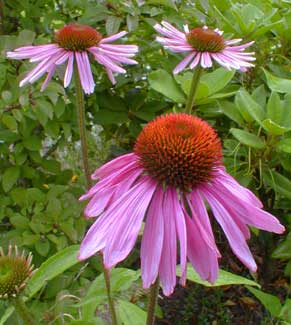
II. Echinacea & Human Health
Echinacea is one of the Europe's & North America's most popular herbal remedies. This popularity is rather unfortunate since doubleblind studies have found it to be ineffective medicinally.The widespread belief is that it boosts the immune system sufficiently to help the body fight off illness & that it is especially useful for upper respiratory illness. Alas, in the best-designed controlled doubleblind studies, echinicea's effectivity for treating respiratory disease is equal to, but no greater than, that of a placebo.
In the United States, there is no government agency that oversees the quality of echinacea & similar products. Independent lab analyses have shown echinicea products frequently have microbial contamination potentially dangerous when taken internally.
A typical analysis as conducted by ConsumerLab.com of five different echinacea products discovered that one product had excessive lead contamination, plus it had a balance of chemical compounds that indicated it was either made from the wrong species or was made primarily from twigs. Four of the products contained a far lower percentage of phenols than expected. If the claims of some herbalists that phenols in echinacea maximize efficacy, then on the basis of herbalists' own dubious claims, efficacy could not be very great for products that have as little as 5% of the phenols the manufacturers allege to be the minimum ingredient.
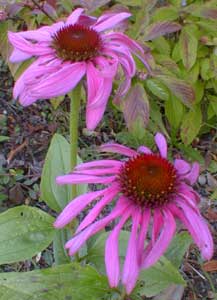 Of the tested products, not even one achieved a minimum level of quality. None of the products contained the levels of phenols & ingredients promised on the label. This indicates that when shopping for echinacea as a home remedy, the odds of randomly or accidentally obtaining a quality product is precisely Zero Percent.
Of the tested products, not even one achieved a minimum level of quality. None of the products contained the levels of phenols & ingredients promised on the label. This indicates that when shopping for echinacea as a home remedy, the odds of randomly or accidentally obtaining a quality product is precisely Zero Percent.So on two fronts millions upon millions of dollars spent annually on echinacea for medicinal purposes is a waste of individuals' healthcare funds: First, doubleblind studies show it to be ineffective beyond the level of a placebo. Second, the manufacturers, perhaps because they know they are selling a worthless product anyway, do not find it necessary to package exactly what their label promises or to meet even the minimum standard of quality.
Even in light of incontrovertible evidence that echinacea is ineffective, many people simply experience religious fervor for herbal remedies in general & for echinacea in particular, & medical reality won't change their beliefs.
I had a young gent with asthma swear to me quite angrily that he would be dead without his nightly dose of echinacea, & he most certainly did not want to hear about the very real health risks associated with habitual use; for while echinacea has never been shown to improve asthamtic conditions, it has been proven to worsen asthma for a minority of users. I'm sure he will go to his grave, perhaps sooner than he'd intended, still believing in the magic of echinacea.
It is, however, very much magical for the beauty of a sunny low-maintenance garden.
Continue to:
'White Swan' Echinacea